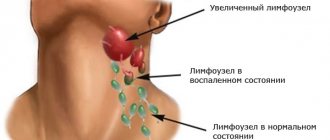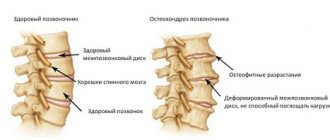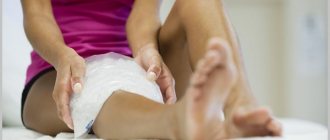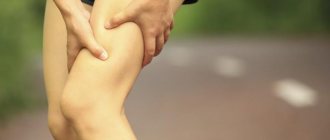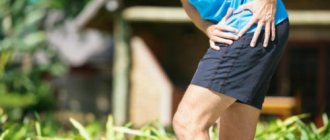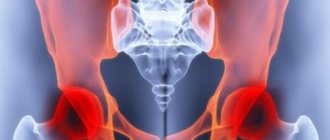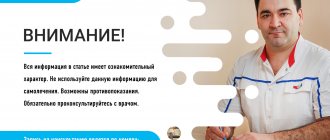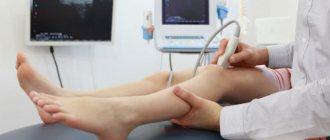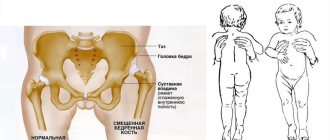Pain in the tailbone occurs much more often when standing up than when sitting. This is due to the anatomical features of this part of the spinal column. It consists of rudimentary vertebrae firmly fused to each other. This is the part of the spine that in the animal world acts as the “engine” of the tail. The man does not have a tail, but the coccygeal bone is preserved. And to some extent it ensures the balance of the body while sitting. In this case, a redistribution of static and shock-absorbing loads occurs on the ischial bones and coccyx.
Incorrect posture, deformation of the pelvic ring, pregnancy, excess body weight, increased intracavitary pressure in the abdominal cavity - this is not a complete list of potential causes of pain in the tailbone when sitting and standing; they are described in more detail in the article.
Acute pain in the coccyx when sitting is almost always a sign of a traumatic violation of its integrity. Similar symptoms are caused by a crack or fracture of a bone, detachment of the periosteum, separation of individual vertebrae, etc. The exception is cases of so-called referred pain, which radiates from the pelvic area, groin or rectum. For example, with a rectal fissure, the patient cannot accurately determine the location of pain and initially consults a neurologist or vertebrologist. After the examination, it turns out that the help of a proctologist is required.
The vertebrae of the coccygeal bone are not separated from each other by cartilaginous intervertebral discs. They grow together during adolescence. Translated from Latin, the name of this department sounds like the name of a bird - cuckoo. It is due to a certain shape of the coccygeal bone, reminiscent of the beak of this bird. The coccyx consists of 4-5 vertebrae. The shape resembles that of the sacrum. The arrangement of the vertebrae can be straight, curved anteriorly or posteriorly, curved.
Idiopathic (without a specific cause) pain occurs quite rarely, in approximately 1 - 2% of the world's population. They may be associated with an improperly organized workplace, with a seat that is too hard. They can also be provoked by various infectious diseases accompanied by a violation of the water-salt balance in the human body.
In the anterior sections, the tendon attachment of the muscles occurs, partially forming the pelvic floor and influencing the functions of the genitourinary organs. Therefore, coccydynia may be associated with inflammatory and destructive pathologies in the bladder, rectum, uterus (in women), and prostate gland (in men). A number of bundles of the gluteus maximus muscle are also attached to this area. Therefore, the coccyx is partially responsible for hip extension and may hurt when this muscle or its tendon apparatus is stretched (for example, when receiving a sports injury as a result of sharp extension of the hip).
During pregnancy, the coccyx changes its configuration and deviates closer to the beginning of labor, forming a canal for the passage of the fetus. If during pregnancy there is a divergence of the pelvic bones, then the coccygeal bone changes its location earlier. After childbirth, this anomaly persists. As a result, a woman develops a serious problem with urinary incontinence, a violation of the innervation of the internal organs of the pelvic cavity. Prolapse of internal organs often develops.
If you experience pain in your tailbone when sitting or getting up from a chair, you should immediately seek medical help. You can make a free appointment with a neurologist or vertebrologist at our manual therapy clinic in Moscow. Experienced doctors work here, who will be able to make an accurate diagnosis during a manual and functional examination. Then the patient is given recommendations for undergoing the examination. An individual course of treatment is developed. The first appointment is completely free for all patients.
Causes of pain at the tip of the coccyx
Most often, discomfort is the result of injury. After a blow to the buttock area, a fall or other impacts, the organ may suffer a fracture or dislocation with all the ensuing consequences.
The second common cause of paroxysmal or constant pain in the lower spine is perianal pain syndrome. It is associated with problems of the colon (constipation, diarrhea), inflammation of the ovaries, uterus and tubes, adhesions after operations (consult a gynecologist).
Pain in the tailbone may be the first symptom of a serious disease of the pelvic organs, colon or spine. Therefore, it cannot be ignored, but you should immediately consult a doctor.
Konstantin Tishchenko
Orthopedist, Traumatologist
Other reasons include:
- Pregnancy. The fruit grows and requires more space. The coccyx, consisting of several underdeveloped vertebrae, deviates slightly back, and such deformation is very acutely felt by the mother’s body.
- Displacement of intervertebral discs. Nerve endings become pinched, causing sharp pain when sitting or trying to stand up. The treatment is carried out by a neurologist.
- Muscle spasm. Some pelvic muscles attach to this part of the spine. Their spasms and problems with the nerve endings of the pelvis are the main cause. An effective remedy for relieving spasticity "Sirdalud".
- Diseases of the pelvic organs (hemorrhoids, prostatitis, paraproctitis).
At risk are people who lead a sedentary lifestyle and office workers. Owners of professions that involve working under constant stress often face this problem.
How to determine the source of pain
The coccyx, or coccygeal bone, is the lower part of the spine, which consists of 4-5 fused vertebrae. It serves as an attachment point for ligaments, muscles, and tendons, so it is somewhat erroneous to consider it a rudiment. Damage to any connective tissue structure associated with the coccyx leads to pain.
The fact that discomfort is localized in this bone is easy to understand. There are several specific signs:
- the area of pain is between the buttocks;
- the most pronounced pain is in the area slightly above the anus, and sometimes located precisely in the anus;
- even slight pressure on the tailbone causes discomfort;
- pain almost always appears when sitting for a long time, especially on a hard chair or stool;
- As you rise, its intensity increases significantly.
Another typical sign that the pain is localized in the tailbone is its rapid disappearance when bending forward. This set of symptoms is called coccydynia. Most often it is found in women over 40 years of age.
How to get rid of pain with the help of medications?
In 90% of cases, it is possible to get rid of the problem with complex and (much less often) symptomatic drug treatment. An x-ray examination is prescribed, anti-inflammatory and painkillers are prescribed.
To relieve pain, take Naproxen or Ibuprofen. For severe pain, the doctor prescribes injections of lidocaine, novocaine or hydrocortisone, Kenalog, Diprospan.
Doctor's advice
Before starting manual therapy, be sure to take an X-ray or MRI of the problem area (coccyx or sacrum), and rule out gynecological and urological pathologies. Trust your body to certified chiropractors of serious medical centers. Treatment by traditional chiropractors is fraught with complications.
Konstantin Tishchenko Orthopedist, Traumatologist
Hydrocortisone ointment combines well with ultrasound treatment. This simultaneously relieves pain in the tailbone and eliminates the very cause of the phenomenon.
Surgeries to remove the rudiment are resorted to only in complex cases of dislocations and fractures that are not amenable to therapeutic intervention.
When and which doctor to contact
It would not be a mistake to contact a general practitioner - a general practitioner. After examination, identifying the cause of pain in the tailbone or if a certain pathology is suspected, the patient will be referred to another specialist. If the patient assumes in advance what triggered the discomfort in the lower back, then it is advisable to immediately make an appointment with a traumatologist, neurologist, orthopedist, endocrinologist, or vertebrologist.
Folk remedies
Pain in the tailbone area is treated with mumiyo ointment (especially effective in case of bruises and fractures), blue clay compresses, and fir oil.
Pain when sitting and standing is also relieved by a ring magnet. It needs to be moved in a circle clockwise for 15 minutes. Repeat 2-3 times a day.
Traditional medicine also includes rubbing of freshly squeezed radish juice mixed with honey and alcohol in a ratio of 300:100:200 ml, respectively. Lubricating the sore spot with iodine works in a similar way (the area of the body must first be warmed up).
Relief at home
NSAID tablets help relieve pain. But they cannot be used for more than a week, as they provoke ulceration of the gastric mucosa. It is better to use products for local application - anesthetic ointments, gels, creams. You can reduce the severity of pain using orthopedic pillows and bandages.
Physiotherapeutic methods of treatment and manual therapy
Manual therapy has the largest number of ways to eliminate pain in the lower back. Basically the technique includes:
- General massages, pelvic floor muscles (if the cause is their spasms), finger massages of the rectal muscles.
- Acupuncture. The specialist selects biologically active points and performs acupuncture. As a result, the intensity of the discomfort decreases or the problem disappears completely.
Physiotherapists also offer electrotherapy, paraffin applications, ozokerite, therapeutic mud, diadynamic currents, UHF, etc.
Diagnostic methods
The diagnosis is made on the basis of an external examination of the patient, his complaints, the presence of injuries, inflammatory or degenerative diseases in the anamnesis.
Palpation
Indicate pain on palpation as the source of discomfort. When pressing on the coccyx, lumbosacral vertebrae, areas where muscles, ligaments, and tendons are located, unpleasant sensations of varying intensity occur. If the severity of pain does not change with increasing mechanical impact, then most likely it is reflected. The most informative is palpation through the rectum. In this way, the mobility of the coccyx structures is assessed, and neoplasms in the large intestine and vagina are excluded.
MRI, ultrasound
Using ultrasound, you can diagnose pathologies of the musculoskeletal system at an early stage of development. The study is carried out to assess the condition of the blood vessels located near the tailbone and in the pelvic organs. Ultrasound is the safest diagnostic procedure that allows you to accurately detect tumors and inflammatory processes in the abdominal cavity.
The MRI images clearly visualize soft, cartilaginous, and bone structures. Diagnostic manipulation is often used when other procedures are not informative.
X-ray
The study helps to identify the reasons that led to the pain of the tailbone. Using radiography, you can diagnose lumbar osteochondrosis, intervertebral hernia, spondylolisthesis. The procedure also allows us to determine the stage of the disease, the degree of tissue damage, and the number of complications that have arisen.
X-ray of the coccyx.
Exercises for the lower back
It is better to combine all the described techniques with physical therapy. If it hurts to sit and get up, then it is not just desirable, but obligatory for the body. Try to perform all exercises on your back slowly, measuredly:
- Lying on your back, squeeze the ball with your feet and straighten your legs. Repeat 6-8 times with an interval of at least 10-15 seconds;
- bend your knees and spread them, lifting your pelvis for 3-5 seconds. The interval and number of repetitions are similar to the first exercise;
- Place your palms on your stomach and hold the ball between your bent knees. Squeeze the ball forcefully for 5-7 seconds.
Pregnant women cannot afford anti-inflammatory medications and powerful painkillers. In such cases, the only option for relief may be a special circle or a soft cushion ball.
When sitting on them, the load on the lower part of the spine is reduced and the woman feels better. In the same way, you can escape from pain in the tip of the tailbone at the beginning of your period.
If you supplement your course of treatment with any medications, consult your doctor so as not to worsen the situation. Move more during the day, walk, do exercises in the morning and very soon your back will stop bothering you.
For more information about the causes of pain in the tailbone and how to treat it, watch the video:
This article has been verified by a current qualified doctor, Konstantin Tishchenko, and can be considered a reliable source of information for site users.
Rate how helpful this article was
3 5 people voted, average rating 3
Did you like the article? Save it to your wall so you don’t lose it!
Elimination of pain in the coccyx
Not every person with sudden pain in the tailbone has the opportunity to visit a doctor. In order to alleviate your plight, at least temporarily, you should take a painkiller (Ibuprofen, Nurofen, etc.). The sore spot should not be overstrained, i.e. It is necessary to exclude heavy lifting, sedentary work, soft and uneven surfaces for sleeping and resting.
In case of severe and acute pain in the tailbone, it is necessary to exclude sedentary work and physical activity.
As already reported above, there are quite a few reasons why the vestigial part of the back fails. The course of further treatment depends on this: inflammatory processes require antibiotics, cysts and tumors are best eliminated with chemotherapy or surgery, fractures and dislocations must be reduced, etc.
Drug therapy
Did you know that...
Next fact
Drug therapy is at the forefront of all treatment methods , because... it is used not only for treatment, but also during the recovery stages (for example, after surgery), as well as for prevention.
The doctor usually begins the course by prescribing non-steroidal anti-inflammatory drugs (Piroxicam, Diclofenac, Indomethacin, etc.).
Important! Medicines in this group have a great impact on the gastric environment, so patients with chronic gastritis, ulcers, etc. should be careful when taking tablets. The course of treatment should not last longer than 5 days.
With pain in the tailbone, the patient often has problems with bowel movements. Psychological and physical discomfort do not have the best effect on the process of defecation. Therefore, experienced doctors prescribe laxatives or microenemas to cleanse the body and eliminate disturbances in the gastrointestinal tract.
Folk remedies
as additional treatment . However, it is worth remembering that it is better to coordinate all prescriptions with your doctor and that they cannot replace a full course for recovery.
- Honey-vinegar mixture. Take 2 parts honey and mix with 1 part vinegar (food grade, 3%). Mix everything thoroughly. Rub the resulting composition into the tailbone every two hours - in case of intense pain, in case of aching pain - 3 times a day.
- Food compress. Mix honey, cottage cheese and kefir in equal parts, add 100 ml of alcohol. Apply to the sore spot and wrap with cling film. Leave for an hour. The course of treatment is 1 week (2 times a day).
- Tincture for pain. Pour 200 g of propolis into 300 ml of vodka and leave in a dark and cool place for 2 weeks. Take 5 drops 3 times a day (before meals). The composition actively improves immunity, has an analgesic effect and helps to recover faster. The course of treatment is 20 days.
- Herbal compress. Fresh wormwood must be chopped with a knife. Add 30 g of dry plantain and 1 onion to it. Grind all ingredients until mushy. Apply 3 times a day on gauze, apply to the back and wrap with a warm cloth.
- Potato treatment. Peel and grate 5 medium potatoes, add a tablespoon of honey and apply to the tailbone.
Exercise therapy and massage
A set of therapeutic exercises helps to significantly strengthen muscles and improve well-being . They must be carried out during the period of remission, because exacerbation of the disease requires complete rest of the affected area.
Approximate complex of physical therapy:
- Starting position - lying on your back, legs and arms extended along the body. Bend your legs at the knees, clasp them completely with your arms and pull them as close to your chest as possible. Release and repeat after 10 seconds.
- The starting position is the same as in the first exercise. Bend your legs so that your feet are as close to your buttocks as possible. Try to gently lift your pelvis, while avoiding pressure on your back. Repeat 7 times.
- Starting position – lying on your stomach, arms and legs along the body. Raise your legs and arms (pull them back) so that your body looks like a boat. Bend over as much as possible. Lower and repeat after 20 seconds.
- This exercise needs to be done by two people. Sit on the floor, bend your knees, bring your feet to the inner thigh (like a lotus position). The second person leans a little on your legs, does not allow you to bring them together, you offer resistance. This exercise perfectly trains all muscle groups of the pelvis and sacral region.
Massage of the tailbone, if necessary, can be performed at home. Considerable progress in the healing process can be achieved with the help of massage .
Of course, it is better to entrust this procedure to a specialist, but if this is not possible, you can perform massage at home.
Manipulations should begin with stroking and patting the entire sacral region. The skin should be slightly red, but it should not be painful.
Basic self-massage techniques are based on acupressure on the inflamed area.:
- turns with force with the index finger and thumb;
- pressing with a hand clenched into a fist.
Finish the session with active kneading of the lower back. In terms of technique, experts compare these manipulations with erasing an inscription on a board.
Video: “Massage for pain in the tailbone”
